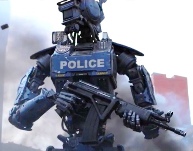ROBOTICS IN LAW ENFORCEMENT

RoboCop released in 1987 tells the story of a Detroit police officer Alex Murphy killed in action and resurrected as a cyborg super-cop with a built-in program to restore law and order. Today science fiction has become a reality. Police in different parts of the world is using robots for law enforcement. The world’s first operational “RoboCop” officially joined the Dubai Police force in May 2017. Since then robots have been deployed for policing in China, USA, in different parts of the world and some states of India.
We initially exploited robots for meeting industrial needs. We deployed them for improving the efficiency and quality of production in industries. We have eventually used them to meet military and law enforcement needs. Policing today is being touched by technology like every other field of human endeavour. Unlike factory bots sliding onto a production line, robocops today are strolling our neighbourhoods and wielding weapons.
 Looking back, Israel first used unmanned aerial vehicles successfully in their conflict with Syria in the early 1980s. It was not until the late 1990s that the U.S. military fully endorsed the use of UAVs for surveillance and conducting airstrikes from a distance. The application of this technology got widely witnessed during the Gulf war conflict in their fight against Al Qaeda and ISIS because of the intention of the USA to curtail troop casualties during surveillance and intelligence gathering missions.
Looking back, Israel first used unmanned aerial vehicles successfully in their conflict with Syria in the early 1980s. It was not until the late 1990s that the U.S. military fully endorsed the use of UAVs for surveillance and conducting airstrikes from a distance. The application of this technology got widely witnessed during the Gulf war conflict in their fight against Al Qaeda and ISIS because of the intention of the USA to curtail troop casualties during surveillance and intelligence gathering missions.
The USA is now using this technology to fight their enemies efficiently and effectively with minimum collateral damage, using a few trained men from remote locations. The Americans and several other countries have now come to accept robotics as a tool for policing, like the way it was adopted in the US military. Although some are cautioning the potential dangers of using robots for policing, eventually, robots are gradually and steadily becoming part and parcel of the police-tool-kit. Over thirty years ago, the science fiction film RoboCop featured a memorable scene in which a giant mega-corporation unravels a law-enforcement droid called ED-209. Launched as “the future of law enforcement,” the new robot’s debut during a demo gets met with an unmitigated disaster when the robot cannot recognise when its identified threat has dropped his gun, resulting in the disastrous obliteration of its target, proving a point that putting one’s trust in autonomous armed police robots could prove catastrophic.
However, there are several areas of policing where robots are being used, such as patrolling, surveillance, anti-terrorist operations and intelligence collection. Patrol robots could monitor the roads/streets for reporting and detecting crimes to human officers. The robots also accurately record the happenings witnessed during the patrol for immediate and future review. The Chinese robot, called AnBot, which they have rolled out into airports and train stations, has facial recognition technology that can track potential criminals and forward information to a central command manned by human operators. Dubai Police introduced its first robot police officer in May 2017. Wearing a police cap and moving on wheels, the robot features a computer touch-screen on its chest that can report a crime or inquire about speeding tickets. Police robots are also making stops, arrests and other serious situations less dangerous. They are also clearing debris from accident scenes.
Robots are also being used in law and order and violent situations to control and safely assess conditions remotely from a safe distance to enable the human officers to develop reliable tactical plans for execution. Atlas robot recently unveiled by Boston Dynamics can move like humans with self-sustaining energy and is controllable remotely. We could use such robots for patrolling in hostile situations. Police in Uttar Pradesh has acquired a set of Skunk drones built to spray crowds with pepper spray and paintball. The drone, manufactured by South African firm Desert Wolf, hovers mid-air over a protest and fires up to 20 paintball (or other “non-lethal” ammunition) per second while simultaneously dispersing tear gas pellets onto people. It’s also fitted with onboard speakers to let police communicate with crowds, and has bright strobe lights and “eye-safe” lasers to disorient and disperse a gathering.
 Robots can also restrict and restrain armed suspects who are likely to hurt humans by opening fire or by using any other weapon or weapons. A robotic firm in Israel has built a Roomba-like gun-toting robot with a built-in 9 mm Glock pistol called “Dogo”. This small land rover can enter a house quietly, climb stairs, and even manoeuvre over obstacles. Ready with eight cameras and two-way audio, the Dogo allows police to communicate with and fire upon suspects without risking their lives. Robots could also access inaccessible crime scenes and generate crime scene reports, mahazers, and collect evidence from the SOC. Robots also seem to have a better ability of electronically recording victim, witness and accused statements without misinterpretation or human bias.
Robots can also restrict and restrain armed suspects who are likely to hurt humans by opening fire or by using any other weapon or weapons. A robotic firm in Israel has built a Roomba-like gun-toting robot with a built-in 9 mm Glock pistol called “Dogo”. This small land rover can enter a house quietly, climb stairs, and even manoeuvre over obstacles. Ready with eight cameras and two-way audio, the Dogo allows police to communicate with and fire upon suspects without risking their lives. Robots could also access inaccessible crime scenes and generate crime scene reports, mahazers, and collect evidence from the SOC. Robots also seem to have a better ability of electronically recording victim, witness and accused statements without misinterpretation or human bias.
Without putting humans at risk, it would be possible to defuse and dispose of bombs using bomb disposal robots remotely. Brazilian police, to inspect suspicious packages during the Olympics held in their country, acquired 510 Packbots, that are military-grade bomb detection and reconnaissance robots. PackBots have capabilities of bomb detection and disposal. The PackBot climbs stairs, manoeuvres in water, and can crawl around at about 6 miles per hour, faster than most adults jog. Similarly, Cleveland police have recently inducted a new robot named Griffin, created by students from a local college which stands 12 inches tall; the six-wheeled rover reaches places that police can’t like under a car or behind dumpsters to look for explosives. Griffin has been fitted with a camera and light, which allows police to monitor and act on a situation remotely from a safe distance. Unlike the military-grade robot, which the police deployed in Dallas, Griffin is light enough to get around quickly and easily with no truck.
The Los Angeles Police Department has inducted a Bat Cat which is short for Bomb Assault Tactical Control Assessment Tool. Bat Cat is a radio-controlled monster that has been designed to pick up a car bomb with its massive, 50-foot telescoping arm. The Bat Cat also can tear through a house in minutes. In 2011, LAPD used it to obliterate the walls of a home during a standoff.
In July 2016, police in Dallas modified a non-lethal bomb disposal robot to deliver explosives to kill a gunman. They clamped a bomb to an explosive-detonation robot and boom: a non-lethal robot became an assassin. Police Chief David Brown allowed his SWAT commanders to plan an ingenious strategy to neutralise a deadly suspect. In response, the Dallas Bomb Squad devised a plan which envisaged innovative use of delivering explosives through a robot to neutralise the deadly sniper Micah Xavier Johnson, a 25-year-old military veteran from Mesquite, Texas who had unleashed sniping attacks one after another which killed 5 Dallas police officers. After a 45-minute shoot-out and a failed two-hour negotiation, the Dallas SWAT team decided to put a stop to the man who swore to slay even more officers. The team put to use a bomb squad robot and halted the siege with no more police officer casualties. This ploy, however, earned attention as the anti-militarization groups came out and vocalised their displeasure.
 Human rights activists worry that these robots lack social awareness critical to the decision-making process. “For instance, during mass uprisings in Egypt in January 2011, the military declined to shoot and kill the protesters, an action that needed inherent human compassion and regard for the rule of law”. Several anti-robotics activists, including Elon Musk and Stephen Hawking, were signatories to a letter that threatened the use of gadgets that can choose targets without human management. Using explosives is bringing up new concerns over the reasonableness to launch a robot to eliminate dangerous suspects instead of continuing to mediate their surrender. Such deadly use of explosives may get the approval of the court, for using it under the conditions of confronting a significant threat. But Police organisations must give serious thought before executing such a choice. Most tactical commanders would have green-lighted the alternative of using a police counter-sniper if there had been a window in that cabin in Dallas. In which case, it would have been a successful risk elimination by a police sharpshooter. In the days to come, robotic weaponry is likely to get used more often; therefore, we may need more officer training and rules of engagement — along with constant legal analysis. Many continue to condemn the use of bomb robots, solely because they perceive it as too hostile.
Human rights activists worry that these robots lack social awareness critical to the decision-making process. “For instance, during mass uprisings in Egypt in January 2011, the military declined to shoot and kill the protesters, an action that needed inherent human compassion and regard for the rule of law”. Several anti-robotics activists, including Elon Musk and Stephen Hawking, were signatories to a letter that threatened the use of gadgets that can choose targets without human management. Using explosives is bringing up new concerns over the reasonableness to launch a robot to eliminate dangerous suspects instead of continuing to mediate their surrender. Such deadly use of explosives may get the approval of the court, for using it under the conditions of confronting a significant threat. But Police organisations must give serious thought before executing such a choice. Most tactical commanders would have green-lighted the alternative of using a police counter-sniper if there had been a window in that cabin in Dallas. In which case, it would have been a successful risk elimination by a police sharpshooter. In the days to come, robotic weaponry is likely to get used more often; therefore, we may need more officer training and rules of engagement — along with constant legal analysis. Many continue to condemn the use of bomb robots, solely because they perceive it as too hostile.
Robots are of different types. Humanoid robots may seem scary, but they have been with us since 2000. Robots may be autonomous or semi-autonomous and range from humanoids such as Honda’s Advanced Step in Innovative Mobility (ASIMO) and TOSY’s TOSY Ping Pong Playing Robot (TOPIO) to industrial robots, medical operating robots, collectively programmed swarm robots, UAV drones such as General Atomics MQ-1 Predator, and even microscopic nanobots. By masquerading as a lifelike edifice or automating motions, a robot may show the existence of intelligence or thought of its own. Autonomous robots are likely to increase in the days to come..
Telerobots are appliances remotely operated from a distance by a human operator. They get used when a human cannot be present on-site to execute a task because it is hazardous, remote, or inapproachable. The robot may be in another country, or maybe in a different locality. For disabling a bomb, the operator may send a small bomb disposal robot to cripple it. Teleoperated robot aircraft, like the Predator Unmanned Aerial Vehicle, are increasingly being employed by the army. These pilotless drones can scan terrain and fire on targets. Several robots such as iRobots Packbot and the Foster-Miller TALON are being used in Iraq and Afghanistan by the U.S. Army to defuse roadside bombs or improvised explosive devices (IEDs) in action known as explosive Ordnance disposal.
Sustaining a growing police force requires huge expenditures which several countries cannot afford so robotics could become a viable alternative to augment an expensive human police force. Today the governments spend crores of rupees of taxpayer’s money towards recruitment, training and salaries for police personnel. Besides, the police personnel incur crores of recurring expenditures in terms of travel bills, medical bills, and other benefits. None of these expenses will accrue if we deploy robots. The United Arab Emirate has big plans for the future. By 2030 it wants robots to make up 25% of its police force,
Eventually, robotic technology will become cheaper and more energy-efficient.A robot called EATR has generated public concerns as it does not need an energy source it continually refuels itself using organic materials. Researchers have devised an engine for the EATR capable of fueling itself on biomass and vegetation available on battlegrounds or other local environments.
Can robots evolve and become spiritual like humans? As human consciousness is nonphysical, it may not be possible for humans to create consciousness in machines. Raymond Kurzweil, an American inventor, futurist and the author of the book “The Age of Spiritual Machines:” believes that the future machines will “proclaim to be conscious, and thus to be spiritual”. He further concludes that “twenty-first-century machines” might go to church, meditate, pray and be able to connect with their inherent spirituality.
Source from: epaper/deccanchronicle/chennai/dt:09.03.2020
 Dr.K. Jayanth Murali is an IPS Officer belonging to 1991 batch. He is borne on Tamil Nadu cadre. He lives with his family in Chennai, India. He is currently serving the Government of Tamil Nadu as Additional Director General of Police, Law and Order.
Dr.K. Jayanth Murali is an IPS Officer belonging to 1991 batch. He is borne on Tamil Nadu cadre. He lives with his family in Chennai, India. He is currently serving the Government of Tamil Nadu as Additional Director General of Police, Law and Order.


